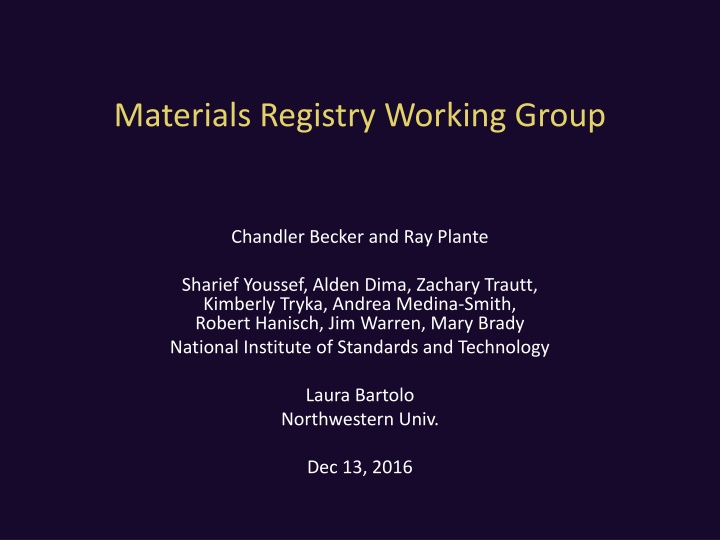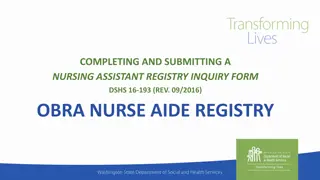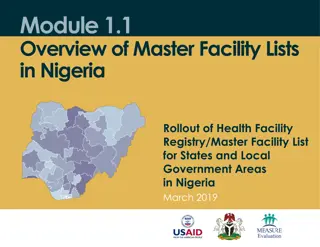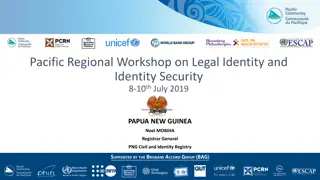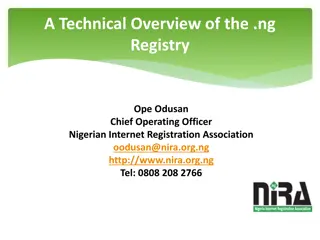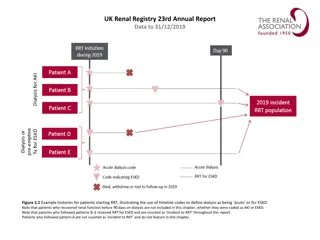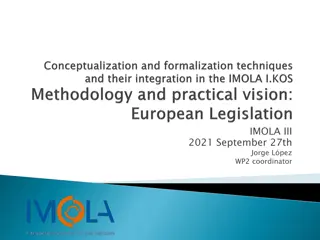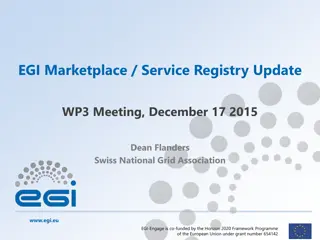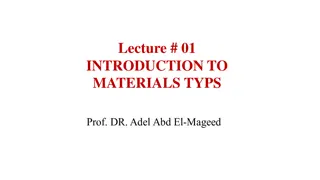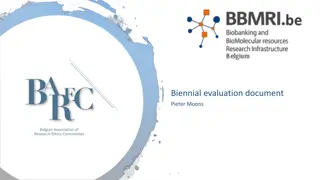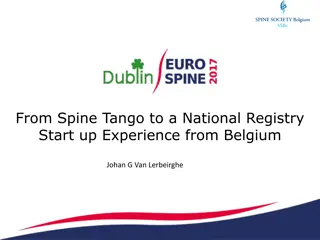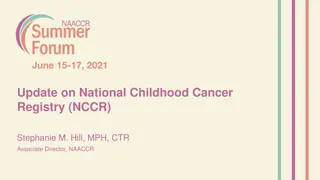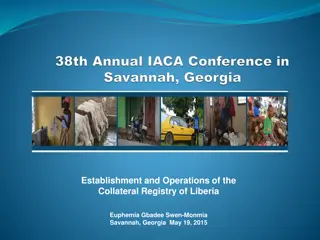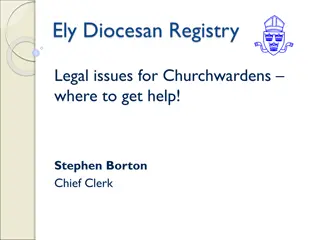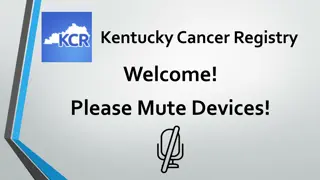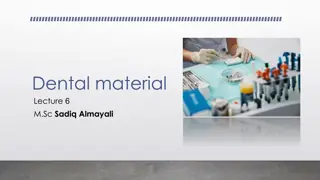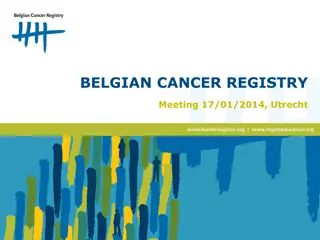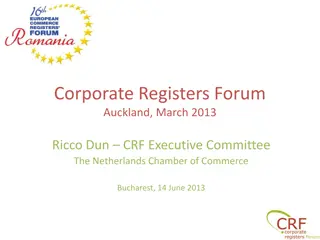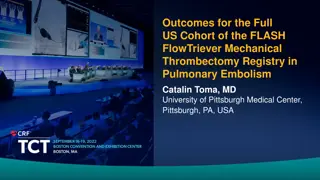Materials Registry Working Group Overview
The Materials Registry Working Group focuses on accelerating the discovery, design, and development of advanced materials through data exchange and infrastructure interoperability. The group aims to link various materials resources to facilitate the sharing of relevant information and datasets. Members include experts from different institutions working towards creating a Registry Federation for comprehensive access to materials data and tools.
Download Presentation

Please find below an Image/Link to download the presentation.
The content on the website is provided AS IS for your information and personal use only. It may not be sold, licensed, or shared on other websites without obtaining consent from the author.If you encounter any issues during the download, it is possible that the publisher has removed the file from their server.
You are allowed to download the files provided on this website for personal or commercial use, subject to the condition that they are used lawfully. All files are the property of their respective owners.
The content on the website is provided AS IS for your information and personal use only. It may not be sold, licensed, or shared on other websites without obtaining consent from the author.
E N D
Presentation Transcript
Materials Registry Working Group Chandler Becker and Ray Plante Sharief Youssef, Alden Dima, Zachary Trautt, Kimberly Tryka, Andrea Medina-Smith, Robert Hanisch, Jim Warren, Mary Brady National Institute of Standards and Technology Laura Bartolo Northwestern Univ. Dec 13, 2016
Materials Data, Infrastructure, & Interoperability (MDII) Interest Group Accelerate discovery, design, & development of advanced materials in time & cost. Explore opportunities for fundamental research & public/private partnerships of data-based services, tools, & applications. Establish free & open data exchange mindful of intellectual property & national security. Exchange computational & experimental materials data through shared online repositories, standardized formats/terminologies, & open programming interfaces.
Motivation for the working group Many materials resources exist (datasets, websites, repositories, registries, etc.), and the number is growing. How can we link them in a way that makes it easier to find and share relevant information and data?
WG members (9/13/16) Brian Matthews Science and Technology Facilities Council Chandler Becker National Institute of Standards and Technology Clare Paul Air Force Research Laboratory Deborah Mies Granta Design, Ltd. Haiqing Yin Beijing Univ. of Science and Tech. James Warren National Institute of Standards and Technology Kathleen Fontaine Rochester Polytechnic Institute (RDA) Laura Bartolo Northwestern Univ. Raphael Ritz Max Planck Society, Garching Raymond Plante National Institute of Standards and Technology Robert Hanisch National Institute of Standards and Technology Scott Henry ASM Sharief Youssef National Institute of Standards and Technology Tobias Weigel German Climate Computing Center (DKRZ) Vasily Bunakov Science and Technology Facilities Council Yibin Xu National Institute of Materials Science Zachary Trautt National Institute of Standards and Technology
What is a Resource Registry? A resource registry is a catalog containing descriptions of resources* that are useful for (materials science) data-driven research * Mainly datasets, databases, and data services * Can also be portals, software, organizations, A starting point for discovering useful data and tools Make high level metadata descriptions searchable Direct users to the web sites that host the data
Building a Registry Federation What does federation mean? Comprised of a network of registries; there is no single Registry Any registry can collect a globally-comprehensive collection of resource descriptions and make it searchable Resource metadata exchange There a common mechanism(s) for sharing descriptions of available data resources Allow local metadata curation Any organization can run registry of their own data resources and share it with the world Why federate? Distribute metadata curation Allow experts who provide/operate data resources to manage how they are described, update descriptions as they evolve No single point of failure (including funding failure) Allow innovation in providing search capabilities How do we federate? Common metadata exchange mechanism We propose starting with OAI-PMH Common metadata schema
Words, words, words For this to work, we need words that describe the resources being registered Some terms are generic (based on Dublin Core (dublincore.org)): Organization Contact information Access methods and locations But others have to be domain- (i.e., materials-) specific Not the complete metadata required to fully document the data in the resource Want to be user-friendly, which currently means selecting from a relatively limited list of high-level terms and using searchable free text
Working group overview Case statement submitted Jan. 2016 Proposed timeline of 12-18 months for a pilot materials resource registry system Approved July 2016 thus dates are now shifted back six months from the original proposal
Full timeline Month 1 (Jul 16) recruit domain specialists to participate in WG Month 2 (Aug/Sep 16) initiate discussions about conducting a survey of existing materials science data providers develop 20 typical data discovery queries to inform metadata discussions Month 3 (Sep/Oct 16) hold meeting to draft 1stversion of metadata extensions to Dublin Core Months 4-8 (Oct 16-Feb 17) disseminate draft to the materials science community, both within and external to RDA, and solicit feedback Month 8 (Feb 17) hold second two-day meeting to refine metadata extensions and establish implementation pilot program E.g., NMRR, MDF, others TBD within WG Months 9-12 (Mar Jun 17) implement pilot federated registry and recruit testers/evaluators evaluate granularity issues write best practices guidelines document Months 13-15 (Jul Sep 17) fine tune metadata definitions and document metadata development process: what worked well, what didn t expand content of pilot registry Months 16-18 (Oct Dec 17) Prepare final document for delivery to RDA
Deliverables Two main deliverables for WG: 1. Report containing materials metadata extensions to Dublin Core 2. Pilot with connected registries to demonstrate harvesting Plus smaller items along the way (meetings, drafts, etc.)
Identification of existing efforts Registries and projects with data sharing enabled E.g., nanoHUB, Materials Data Facility, NoMaD, NIMS, Citrine, + ? Ontologies, vocabularies, etc. Collaboration with other researchers working on similar materials metadata problems XML-based schema repository under development
Previous wordplay work Some schemas, vocabularies, and ontologies MatML, ThermoML, Plinius ontology, Ashino ontology, MatOnto, PREM P, ONTORULE (steels), SLACKS, MatOWL, matvocab Nice review article: X. Zhang, C. Zhao, and X. Wang, Computers in Industry, 73 (2015) 8-22. Cover various areas but not everything Some are being developed (at all levels), others are dormant Others are proprietary or haven t been publicly released
Development of MatSci vocab for NMRR Material type category: Material type(s) Structural features Properties addressed Experimental methods Computational methods Synthesis and processing Material type(s) Material type(s) Material type(s) Material type(s) Material type(s) Material type(s) Material type(s) Material type(s) Material type(s) Material type(s) Material type(s) Material type(s) Material type(s) Material type(s) Material type(s) Material type(s) Material type(s) Material type(s) Material type(s) Material type(s) Material type(s) Material type(s) Material type(s) Material type(s) Material type(s) Material type(s) Material type(s) Material type(s) Biological Biomaterials Ceramics Ceramics Metals and alloys Metals and alloys Metals and alloys Metals and alloys Metals and alloys Metals and alloys Metals and alloys Metals and alloys Metals and alloys Metamaterial Molecular fluids Organic (Carbon-containing) Organometallic Oxides Polymer Polymer Polymer Polymer Polymer Polymer Polymer Semiconductor Semiconductor Semiconductor . . . Perovskite . Al-containing Commercially pure metals Cu-containing Fe-containing (inc. steel) Intermetallics Mg-containing Ni-containing Refractory . . . . . . Copolymer Elastomer Homopolymer Polymer Blend Thermoplastic Thermoset . II-VI III-V
RDA & Pilot Registry websites Interest group https://rd-alliance.org/groups/rdacodata-materials-data- infrastructure-interoperability-ig.html Working group https://rd-alliance.org/groups/working-group-international- materials-resource-registries.html Case statement https://rd-alliance.org/group/international-materials-resource- registries-wg/case-statement/case-statement-rda-working- group Pilot NIST Resource Registry http://matsci.registry.nationaldataservice.org/
